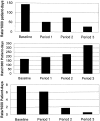The impact of computerized physician order entry on medication error prevention
- PMID: 10428004
- PMCID: PMC61372
- DOI: 10.1136/jamia.1999.00660313
The impact of computerized physician order entry on medication error prevention
Abstract
Background: Medication errors are common, and while most such errors have little potential for harm they cause substantial extra work in hospitals. A small proportion do have the potential to cause injury, and some cause preventable adverse drug events.
Objective: To evaluate the impact of computerized physician order entry (POE) with decision support in reducing the number of medication errors.
Design: Prospective time series analysis, with four periods.
Setting and participants: All patients admitted to three medical units were studied for seven to ten-week periods in four different years. The baseline period was before implementation of POE, and the remaining three were after. Sophistication of POE increased with each successive period.
Intervention: Physician order entry with decision support features such as drug allergy and drug-drug interaction warnings.
Main outcome measure: Medication errors, excluding missed dose errors.
Results: During the study, the non-missed-dose medication error rate fell 81 percent, from 142 per 1,000 patient-days in the baseline period to 26.6 per 1,000 patient-days in the final period (P < 0.0001). Non-intercepted serious medication errors (those with the potential to cause injury) fell 86 percent from baseline to period 3, the final period (P = 0.0003). Large differences were seen for all main types of medication errors: dose errors, frequency errors, route errors, substitution errors, and allergies. For example, in the baseline period there were ten allergy errors, but only two in the following three periods combined (P < 0.0001).
Conclusions: Computerized POE substantially decreased the rate of non-missed-dose medication errors. A major reduction in errors was achieved with the initial version of the system, and further reductions were found with addition of decision support features.
Figures

References
-
- Allan EL, Barker KN. Fundamentals of medication error research. Am J Hosp Pharm. 1990;47:555-71. - PubMed
-
- Barker KN, Allan EL. Research on drug-use-system errors. Am J Health Syst Pharm. 1995; 52:400-3. - PubMed
-
- Lesar TS, Briceland LL, Delcoure K, Parmalee JC, Masta-Gornic V, Pohl H. Medication prescribing errors in a teaching hospital. JAMA. 1990;263:2329-34. - PubMed
-
- Folli HL, Poole RL, Benitz WE, Russo JC. Medication error prevention by clinical pharmacists in two children's hospitals. Pediatrics. 1987;79:718-22. - PubMed
-
- Bates DW, Boyle DL, Vander Vliet MB, Schneider J, Leape LL. Relationship between medication errors and adverse drug events. J Gen Intern Med. 1995;10:199-205. - PubMed
Publication types
MeSH terms
LinkOut - more resources
Full Text Sources
Other Literature Sources
Medical

